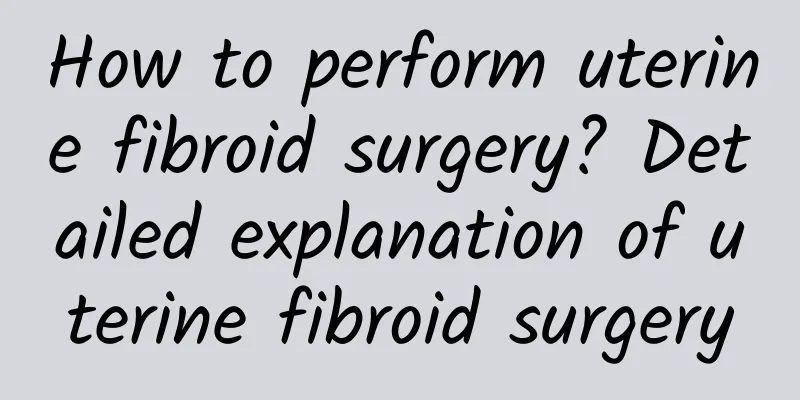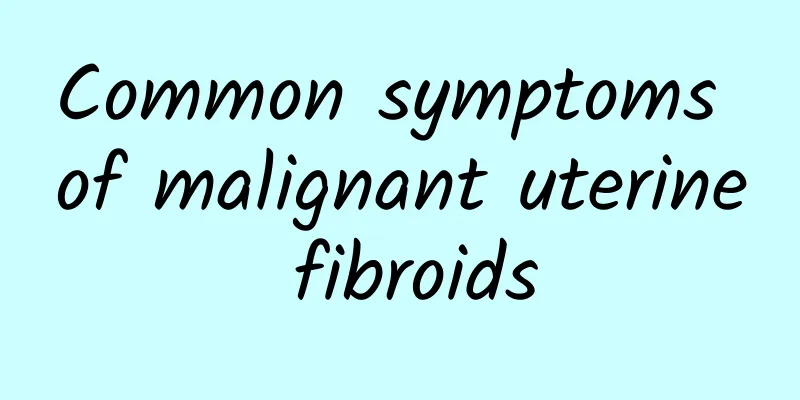How to perform uterine fibroid surgery? Detailed explanation of uterine fibroid surgery

|
Uterine fibroids are the most common benign tumors of the female genitalia. Most are asymptomatic, and a few present with vaginal bleeding, abdominal tumors, and compression symptoms. With the widespread use of minimally invasive surgery in clinical practice, most uterine fibroid surgeries can be performed through laparoscopy and hysteroscopy. So what are the steps of uterine fibroid surgery? Uterine fibroid surgery steps: 1. Caesarean section, in the lower abdomen, there are four layers: skin, subcutaneous tissue, rectus sheath, and peritoneum. In this process, we should also pay attention to the problem of bleeding. If many small bleeding points are not treated in time, they will continue to bleed, making the surgical field unclear. If the operation time is long, it will also lead to unnecessary excessive blood loss. Generally speaking, use hemostatic forceps for a period of time before cutting. 2. Expose the surgical field, find the uterus, and determine whether the uterus and fibroids are consistent with the preoperative diagnosis. 3. Find, separate, cut and suture the round ligament of line 7. 4. Make a small hole in the avascular part of the broad ligament. Clamp the fallopian tube and the ovarian ligament, and pass the clamp tip through the hole. Cut and suture. The peritoneum is folded open and peeled downward to expose the cervix. Be careful not to injure the bladder. 6. Find the uterine movement and vein on the cervical side, clamp the blood vessels close to the cervix (to prevent damage to the ureter), cut and suture. Then deal with the uterosacral ligament and cardinal ligament. 7. Touch the vaginal end of the cervix with your hands, make a small incision on the anterior vaginal dome, and cut off the vagina along the dome ring. Disinfect the incision with 5% iodine and 75% alcohol. 8. Suture the vaginal stump and peritoneum. 9. Check the abdomen for hemostasis before closing the abdomen. The pelvic infundibulum ligament, uterine blood vessels and the downward bladder are prone to bleeding. If loose adhesions are found after laparotomy, blunt separation can be used. If the adhesions are dense, try to separate them sharply under direct vision instead of forcing blunt separation. |
<<: When must patients with uterine fibroids undergo surgery? Pay more attention to these 4 symptoms
>>: What should patients with uterine fibroid surgery eat? Dietary care methods for uterine fibroids
Recommend
Is it normal for a little girl to have a 20-day menstrual cycle?
A 20-day menstrual cycle in a little girl is gene...
Auxiliary examination of uterine fibroids How to treat uterine fibroids
Uterine fibroids grow rapidly and can undergo dif...
Experts remind how to prevent adnexitis
How to prevent adnexitis is a question many women...
Developing good habits is the key to preventing vaginitis
In modern society, changes in social and living e...
What is the cause of uterine contraction miscarriage
What is the cause of miscarriage due to uterine c...
Do you know what causes pelvic inflammatory disease?
Pelvic inflammatory disease is a common disease, ...
What are the common symptoms of adnexitis in women?
I believe that many women are aware of the high i...
How much does it cost to treat cervical warts?
Cervical warts are not as terrible as many women ...
Failure to lose weight is related to it! Look at the two hidden reasons
For those who "started to lose weight with t...
TCM diagnosis and treatment of anovulatory functional uterine bleeding
Menstruation, as a normal physiological phenomeno...
What are the symptoms of mild vaginitis
What are the symptoms of mild vaginitis? First: T...
Are you using the right method to lose weight during the menstrual cycle? Chinese medicine practitioner Luo Peilin revealed: "This time" after menstruation is the most effective
Smart women know how to use their menstrual cycle...
What medicine can cure cervical erosion quickly? 3 kinds of oral medicines and 3 kinds of external medicines for treating cervical erosion
Cervical erosion causes great harm. Patients are ...
Is vulvar leukoplakia vitiligo?
Vulvar leukoplakia, also known as female vulvar l...
How long is the recurrence period of cervical warts?
Cervical condyloma acuminatum is indeed a sexual ...









